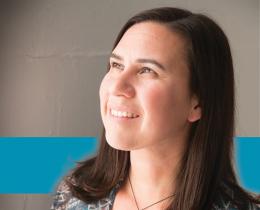When my friend Melissa’s daughter Anna was about 12, she noticed that her belly was expanding—it looked as though a lifesaver was sitting on top of her hips, gently encircling her body. It was with some alarm that she said to her mother, “Look, Mom—I’m fat!”
Like all our daughters, Anna was beautiful and unique. She was a creative introvert, a reader, and she loved nature. What she didn’t know, until Melissa reassured her, was that nature was creating a lifesaver on her sweet belly. Mother Nature, in all her wisdom, was preparing a reserve for Anna’s imminent growth spurt. Furthermore, the adipose tissue (that would be fat) on her belly was busy making estrogen, so that she could become the beautiful 23-year-old woman she is today.
But this story would be incomplete if I didn't tell you how Melissa reassured Anna. Melissa is an extrovert, a brilliant nutritionist who works with women and girls who have eating disorders, and an amazing mom. To Anna’s comment, “Look, Mom—I’m fat!” Melissa said, “Fat! Fantastic! Let me see your beautiful fat!” And she proceeded to explain to Anna what her beautiful and smart body was up to. In the same way that she would celebrate her daughter’s first period a few months later, the appearance of the lifesaver around her daughter’s middle was cause for celebration. Clearly this F word was not a bad word in Anna’s family.
When I was a teenager, the model Twiggy was the rage. Stick-thin with no breasts to show, no hips, and a tiny butt. We girls dreamed of looking like her. It did not matter that she was either anorexic or a genetic rarity—if she could be skinny, so could we! In my day, Twiggy’s body image was the impossible and unhealthy standard and yet many of us began our first diet.
These days, there are too many too-thin models and actresses to name or to count. Furthermore, we can’t trust the bodies that our daughters are seeing in magazines or online because most of them have been airbrushed. Our daughters are constantly inundated with images of women’s bodies that are not only impossible to obtain (without an eating disorder)—most of them are not even real! It is no wonder that eating disorders are epidemic and that the demand for cosmetic surgery is at an all-time high.
What’s a mother to do? Plenty. Research has shown that no matter how inundated our daughters are by these impossible images and standards, we are still their greatest influence. We are our daughter’s example—and, trust me; she is watching you for cues on how to be a confident woman in this crazy world of ours. If you have conflicts with food or your body’s size or shape, I urge you to heal those conflicts. Then your daughter will be part of the healing and the evolution of your matriline.
Like many in her generation, my mother started dieting after the weight gain of pregnancy. Like many in my generation, I started dieting when I was a teenager. There is an alarming trend happening in my daughter Eliza’s generation: Girls are starting to restrict their food intake before puberty. As their natural womanly curves develop, a growing number of preteen girls think they are “getting fat.” These girls now see skipping lunch as cool and dieting as a “grown-up” thing to do. Whether their dieting begins before or after puberty, I believe we need to know and to teach our daughters that diets aren’t healthy and, furthermore, diets don’t work.
This was a revolutionary piece of information that I learned in my early 20s, when I read the groundbreaking book, Fat is A Feminist Issue, by Susie Orbach. Thus began the healing of my poor body image. I had begun dieting as a teenager because I did not like my body, and the more I dieted, the more I binged and gained weight.
Geneen Roth teaches us what she calls the Fourth Law of the Universe: “For every diet, there is an equal and opposite binge.” I learned to love my feminine curves and to trust my body’s physiological cues, and I made peace with my body and with food. When I became a mother, I was able to trust my own instincts because I had embraced Susie Orbach and Geneen Roth’s very sane approaches. As a mother, I raised my daughter Eliza with a healthy body image, and she inherited a sane attitude about her unique, developing adolescent body.
To help other mothers when facing body image issues with their daughters, here are a few of the guidelines I recommend to mothers:
1) Heal your issues with food and your body. It is never too late to do this, and it will have a big influence on your daughter’s self-image and self-esteem.
2) Consider making your home a scale-free zone. Recently, at age 20, Eliza thanked me for doing this. She is grateful that, through the teen years, she did not have a number in her head to obsess about.
3) Keep fashion magazines out of the house. Research has shown that girls’ self-image plummets when they look at fashion magazines regularly. Teach your daughter that these images have been airbrushed.
Teach your daughter that there is way more to life than body image. Teach your daughter that she is uniquely beautiful inside and out! In spite of the insanity that surrounds us in this media and image-obsessed world, if you know this about yourself, you will be able to show her the way.



